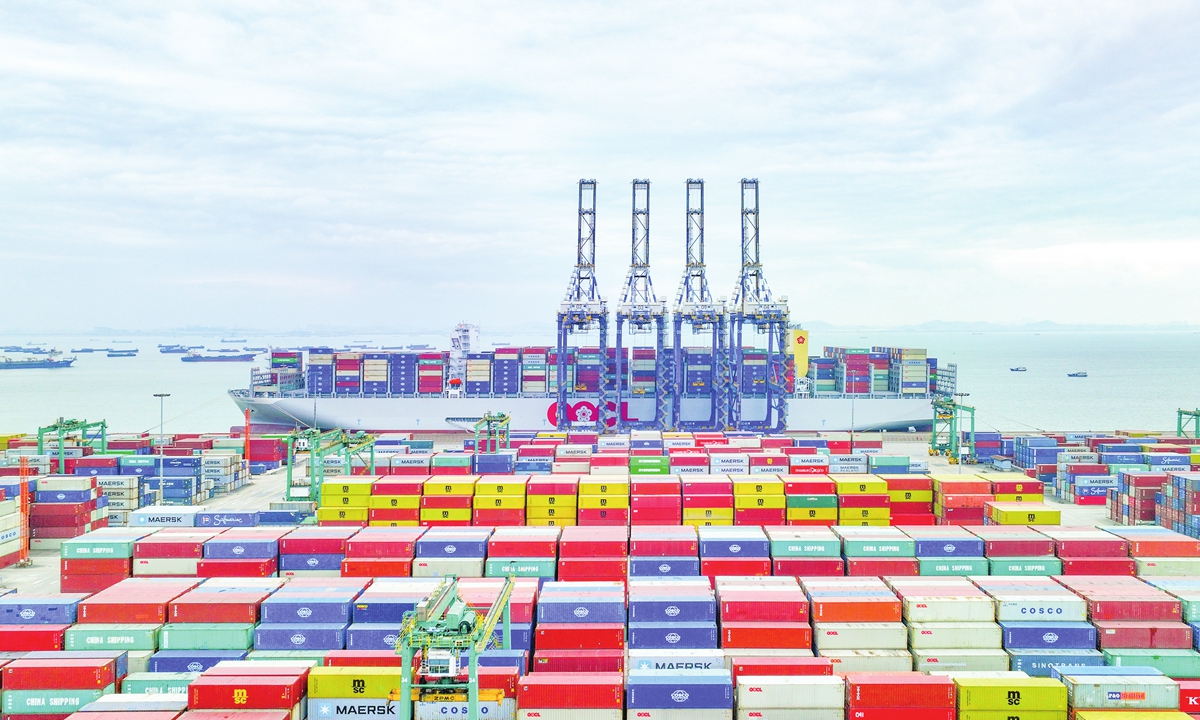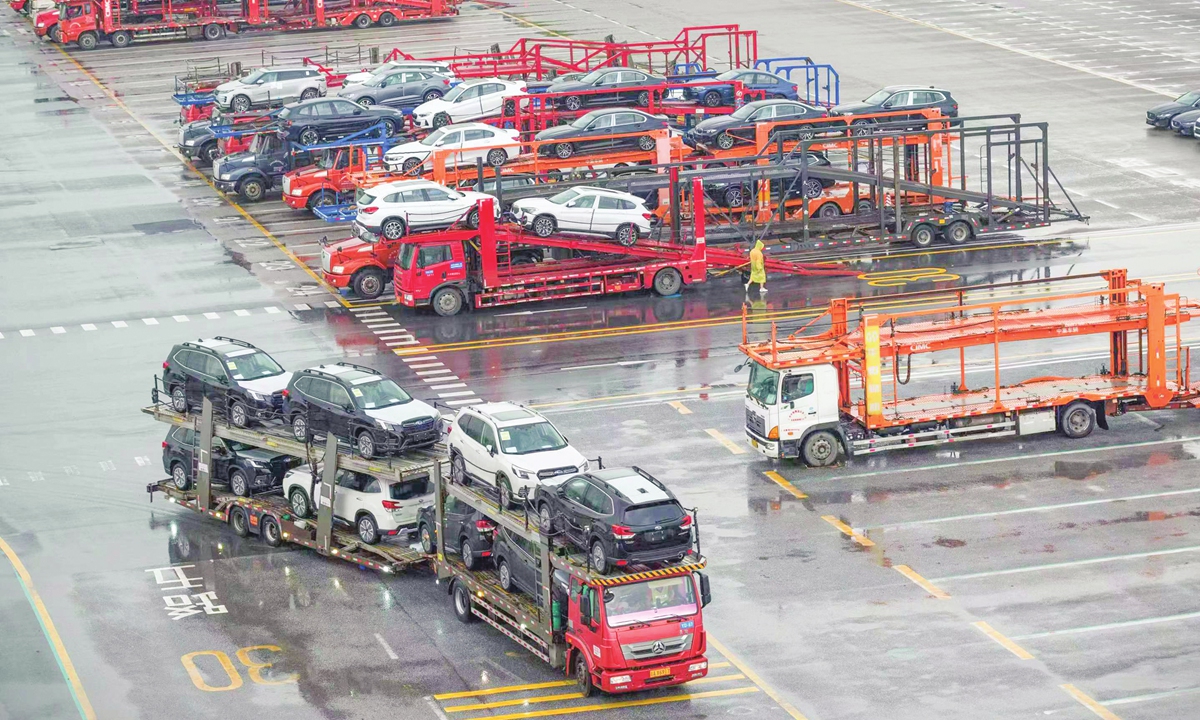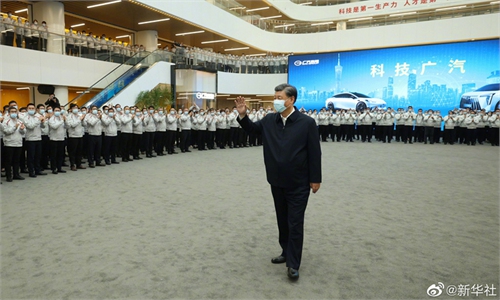Port of Guangzhou strives to serve the BRI by putting investment in infrastructure, carving out new business

A container terminal at the Port of Guangzhou in Nansha district Photo: Courtesy of the Port of Guangzhou
Editor's Note:
This year marks the 10th anniversary of the China-proposed Belt and Road Initiative (BRI), a platform for international cooperation that demonstrates China's vision and provides solutions for the reformation of the global governance system and other multifaceted challenges. There has been no shortage of evidence demonstrating the BRI success, a momentum that relentless Western crackdowns and smears were unable to curtail. Standing at this monumental juncture, the Global Times is publishing a series of articles to help readers understand the fruitful journey of the BRI over the last decade from multiple perspectives, and how the initiative will positively commence over the year. This is the fourth installment in the series, examining how traders, ports and producers in Port of Guangzhou, the world's fifth-largest port, have witnessed the development of BRI at the frontline.
The Port of Guangzhou's links with the maritime Silk Road is time-honored.
Not far away, the Nanhai No.1, an ancient Chinese vessel that carries fine ceramics and many other products, lie in a specified museum, telling the story of the port's thousands of years of maritime trade with the Middle East and Asia.
Since 2013, the Port of Guangzhou, the world's fifth largest port, has been actively engaged in the Belt and Road Initiative (BRI) by investing heavily on infrastructure that allowed whole new sections of business to be created, bringing benefits to the local and regional economy and creating opportunities for countries and regions.
On Tuesday, Huang Bo, general manager of Guanghzou Port Group, announced at an investment promotion forum that the company plans to invest another 35 billion yuan ($5.09 billion) over the next five years to build more wharfs, railway connections, logistics facilities and digital hardware in its Guangzhou Nansha Port, per a report by Nanfang Daily.
The company has accumulatively invested a total of 50 billion yuan ($7.27 billion) in the area in recent years.
'Big refrigerator'
One example is the port's Nansha International Cold Chain Allocation Center, the largest independent cold storage in Asia with a capacity to store 230,000 tons of cold and frozen goods.
This facility, dubbed as "the big refrigerator," costs 1.96 billion yuan and was put into operation in May 2022. It was erected on an area of marshland during the past decade.
"The participation in the BRI has, to a large extent, remade the Port of Guangzhou in terms of the newly added infrastructure in recent years and the new capacity gained," Dong Lei, executive deputy general manager with Guangzhou Port Logistics Co, told the Global Times on Thursday.
These changes not only affected the port as a producer, but also improved the quality of lives of millions of consumers, Dong said. "For instance, because of China's increased capacity in cold chain logistics, consumers now can buy durians at a cheaper price than before, and for cherries, they can now choose from a dozen types of varieties, instead of just a few not long ago."
With the investment in new infrastructure such as the big refrigerator, the Port of Guangzhou has been witnessing explosive growth linked to its fruits trade, meeting Chinese consumers' demand as well as bringing opportunities to suppliers along the BRI markets.
Since 2019, the port has become the single largest port of entry for Chilean cherries, and the imports volume jumped by 300 percent, according to the port authorities. In the last cherry season, the port handled over 5,600 standard containers of Chilean cherries weighing 112,000 tons.
"Nowadays some 70 percent of the cherries enter the Chinese market through southern Chinese ports, of which Port of Guangzhou is a key one, and as the gravity of my business shifts southward, I plan to move my home from Shanghai to Guangzhou to be close to the business," Gonzalo Matamala, general manager of Chile-based cherry supplier Giddings Fruit's Asia and China region, told the Global Times on Thursday.
Having the big refrigerator means there can be more types of business. In addition to cherries from Chile, coconuts from Thailand and papaya from Vietnam, the Nansha International Cold Chain Allocation Center handled its very first cargo of meat shipment from Thailand in March, carving out a new business section, after having secured relevant certification.
Guangzhou's Nansha district, where the facility is based, strives to turn its cold chain industry into a 100-billion-yuan business, according to media reports.

Transport trucks move cars inside a depot at Nansha Automobile Port in Guangzhou, South China's Guangdong Province on April 19, 2023. Photo: Chen Tao/GT
More shipping lanes
As China's trade with the BRI markets has become one of the most fast-growing market segments, the Port of Guangzhou also opened more shipping lanes to establish connections.
In 2022, while China's overall foreign trade grew by 7.7 percent, trade with BRI markets grew by 19.2 percent, customs data showed. In the first quarter of 2023, trade with countries within the BRI network increased by 16.8 percent year-on-year, while that of the Regional Comprehensive Economic Partnership (RCEP) members rose by 7.3 percent.
In 2022, the Port of Guangzhou added 13 new container shipping lanes linking the BRI markets and signatory countries to the RCEP trade deal, with regular connections to Thailand, Vietnam, Australia and Russia.
New-energy products, batteries and automobiles are also becoming mainstays, according to the port's operator.
"The BRI market is expanding and the demand for Chinese goods has risen. To reflect such a change, we added a monthly regulator freight service to Southeast Asia since September 2022," Yang Anning, a manager with Nansha Automobile Port, told the Global Times on Thursday.
"These freight vessels carry automobiles and construction equipment, all highly sought-after products in Southeast Asia," said Yang, whose port is the largest cluster of terminals for ro-ro vessels for wheeled cargo in South China.
BRI bond
To fund its infrastructure investment, the Guangzhou Port Co, the holding company of the port, issued the country's first Belt and Road and science and technology innovation corporate bonds in 2022, raising 1 billion yuan.
In May 2022, the Guangzhou Nansha Port, under the Port of Guangzhou, launched its first freight train to Europe, boosting the BRI growth.
The bond between the time-honored port and the Maritime Silk Road has become even closer over the past decade.



